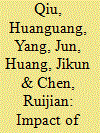| Srl | Item |
| 1 |
ID:
176659


|
|
|
|
|
| Summary/Abstract |
Electrical energy storage is often proposed as a solution for the mismatch between supply patterns of variable renewable electricity sources and electricity demand patterns. However, effectiveness and usefulness of storage may vary under different circumstances. This study provides an abstract perspective on the merits of electrical energy storage integrated with decentralized supply systems consisting of solar PV and wind power in a meso-level, residential sector context. We used a balancing model to couple demand and supply patterns based on Dutch weather data and assess the resultant loads given various scenarios. Our model results highlight differences in storage effectiveness for solar PV and wind power, and strong diminishing-returns effects. Small storage capacities can be functional in reducing surpluses in overdimensioned supply systems and shortages in underdimensioned supply systems. However, full elimination of imbalance requires substantial storage capacities. The overall potential of storage to mitigate imbalance of variable renewable energy is limited. Integration of storage in local supply systems may have self-sufficiency and cost-effectiveness benefits for prosumers but may have additional peak load disadvantages for grid operators. Adequate policy measures beyond current curtailment strategies are required to ensure proper distribution of benefits and responsibilities associated with variable renewable energy and storage.
|
|
|
|
|
|
|
|
|
|
|
|
|
|
|
|
| 2 |
ID:
079064


|
|
|
|
|
| Publication |
2007.
|
| Summary/Abstract |
This study aims to examine the impact of the China-ASEAN Free Trade Area (CAFTA) on China's international agricultural trade and its regional agricultural development, using the Global Trade Analysis Project model and the China Agricultural Decision Support System. Our analysis showed that: (i) CAFTA will improve resource allocation efficiencies for both China and ASEAN and will promote bilateral agricultural trade and, hence, will have positive effects on the economic development of both sides; (ii) CAFTA will accelerate China's export of the agricultural commodities in which it has comparative advantages, such as vegetables, wheat and horticultural products, but at the same time bring about a large increase in imports of commodities such as vegetable oil and sugar; and (iii) CAFTA will have significantly varying impacts on China's regional agricultural development because of large differences in the agricultural production structure in each region. Our results indicate that agriculture in the northern, northeastern and eastern regions of China will benefit from CAFTA, whereas agriculture development in southern China will suffer. Those regional specific impacts are quite different from the effects brought by multilateral free trade treaties, such as those of the WTO, which usually have positive effects on south China but negative impacts on the northern and western parts of China
|
|
|
|
|
|
|
|
|
|
|
|
|
|
|
|